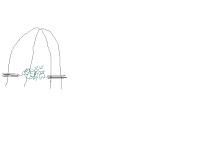We now call Toola our 'surrogate' cat, and she performs this role enthusiastically. When we sit at our bistro table outside, she jumps onto Steve's lap -- kneading and purring with glee. Being allergic to cats, I try not to touch her, but we've had lots of good talks, at the table or when I'm gardening.
Toola is not the only cat who uses our catnip regularly. Her sister מִשׁיִי (pronounced Meshy but probably not transliterated that way). Jacob told me that מִשׁיִי is the Hebrew word for Silky, which describes her coat -- much the same colors as Toola's but evidently much softer.
I know how to spell Toola's name (based on the Hebrew word for Cat, but without an initial Cha syllable) because I am able to read her tag. Meshy does not permit this level of intimacy, but I have seen her enjoying the catnip.
Then one day last week I walked out the back door early in the morning and heard loud meows. The three-legged black cat, obviously needing attention and/or food, approached me and rolled submissively at my feet. I couldn't resist petting the silky black fur and was happy to see (and feel) that the coat was in wonderful condition. Viscous was the word on its tag, along with some numbers I wasn't able to read.
Questions abound. Had someone misspelled Vicious (certainly not an apt name for my new friend)? How was the leg lost (it's a very well healed surgical removal)? Was the new submissive attitude caused by hunger, a catnip' high,' or something else? Was this cat new to the neighborhood and now more 'at home' than when it climbed a tree to get away from me? Will I see it again?
A posting on Craigslist and an entry in a lost and found pet database have not produced any results so far.
Without going into a big T.S. Eliot explanation, I think Vivian would be a good name for this ineffably silky cat.
- - - - -
* Each of the two wires is about 18" long and each of the four ends sticks about 4" into the ground, so this drawing is not to scale. Like most of my drawings, it needs an explanation.of 1000 words or more but is only worth 25 or less. The green stuff is the catnip; the horizontal lines represent ground level; the wires are placed at right angles to each other. Hope it gives you the general idea.

